Persona 3 Portable: The Almost Definitive Redux of an Iconic RPG
When you look at Persona games, and really the Shin Megami Tensei franchise as a whole, by and large, they're RPGs that are always concerned with self-improvement. Atlus has a knack for delving into its back catalog and not only fixing what was broken in the past, but experimenting with things that still work anyway. The fruits of those labors don't always pay off, but when they do, they make for an experience that tells you those games are forward-thinking. That mentality naturally puts Persona 3 Portable, a quasi-remake for the PSP based on the PS2 RPG from 2007/2008 in a weird position. The underlying question that has to be asked first regarding the game is whether it has the chops to still stand up on its own now. Even in the face of gameplay advancements made by Persona 4 and even spin-off titles like Devil Survivor, does P3P have what it takes to be a relevant, compelling game in today's terms? The basic answer to that is a hardy yes. Although in practice some of the new features may come with noticeable setbacks and issues, P3P nevertheless accomplishes enough to prove that the Persona 3 experience is still a very worthwhile one today.
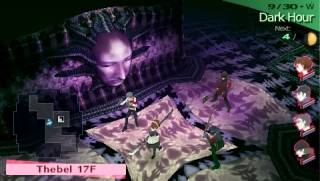
For those unfamiliar with the premise, P3P has you playing the role of the new kid in high school. For reasons unknown, you've made the journey by yourself to the urban and affluent Tatsumi Port Island so that you can attend the local Gekkoukan High School as a second-year student. There's just one slight problem with all the proceedings: the Dark Hour, which transforms your new home into a pretty grotesque and undesirable place. Most people unwittingly turn into coffins and what's worse, your new school also transforms into Tartarus, a looming tower filled to the brim with ominous creatures known as Shadows. But since you possess the power of Persona, a being from the inner recesses of your mind that represents your self-identity, you can actually do something about these problems. Together with your other Persona-wielding friends, it's your hope that you can ultimately rid your new home of its problems before things get out of hand.
Although the story starts off simply enough, it does get more complex and nuanced, widening the scope pretty significantly. However, the game's excellently written characterizations and dialog make it easy to comprehend what's happening on-screen and even find ways to relate to the characters despite their abstract situation. It's a game whose thoughtful, deliberately contemplative story relies on its cast, a group of (predominantly) teenagers with their own problems they have to deal with even in the regular lives, a tactic that's extremely effective at making them endearing. As a narrative formula, it still holds up extremely well today, continuing Persona 3's legacy of being one of the better-written and effective story-centric games in the medium.
The actual gameplay portion of P3P is by and large the same as it was before. Your main concern is in finding the right balance in maintain normalcy in your daily Social Life with your ongoing training in Tartarus for boss fights. The former mostly involves a process known as Social Linking, in which you hang out with a character and gradually get to know them. By the end, not only have you become close friends with them, but you've probably helped them overcome a difficult ongoing life issue. Some people, like main cast member Yukari, have family problems that are proving to be increasingly difficult to deal with, while others have self-esteem problems and still others have unique quandaries, like the case of a guy who has to live with a grim genetic disease.
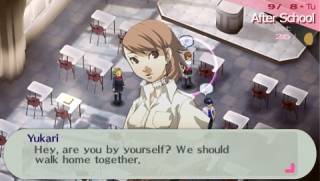
Although the general gameplay incentives for doing these Social Links are unlocking new Personas and strengthened existing ones, the narrative quality is also motivation enough to see them through from start to finish. As little vignettes within a much larger plot, they're not necessarily as important as the main proceedings, but they do help flesh out the world and the motivations of its characters, especially with regards to your fellow party members. Even in the midst of such a surreal situation, everyone is still a human being in the end and that goes a long in ensuring you care about the characters.
The other half of the game is naturally its combat-related portions. Most of the actual fighting and grinding takes place within Tartarus, where your objective is to explore all 200-plus floors, hopefully finding a way to rid it of the process. That sounds like a daunting task, but the fact that you have an entire year in the game means you don't have to rush through it or sacrifice Social Linking opportunities to pursue it. The combat mechanics themselves are straightforward, containing a system of strengths and weaknesses revolving around both physical and magic attacks. As the only person in your party who can have multiple Personas, exploiting this system is especially important for survival, since being flexible is key.
Going hand-in-hand with the fighting is the fusion system, an SMT mainstay. Essentially letting you recycle Personas and their abilities for stronger ones, fusing is a highly important part of the game. Not only does it keep your roster fresh, but it keeps your main character in the best shape for tackling increasingly difficult situations in Tartarus. The fusing process itself can become a bit tedious thanks to how the game randomizes which abilities your new Persona will inherit from the old ones each time you select. But the rewards and potential power you can get from learning the system still make the fusing process and integral part of the gameplay.
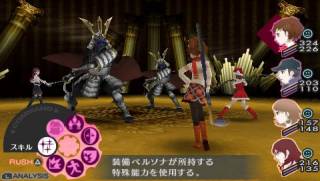
All of this sounds like par for the course for those familiar with either Persona 3 or 4, which is why Atlus has ensured that a bevy of new features were added to justify a third edition of Persona 3. The really big, dramatic ones are sweeping enough that they go really far in making the experience feel different. On the storyline front, these include things like being able to play as a girl, a choice that affects the story in a lot of ways both major and subtle. Playing as a girl means getting altered plot dialog and exclusive Social Links available only to her. Neither of them completely change the basic course of the main game, but their impact can still be felt in ways similar to differences in being a male or female protagonist in something like Mass Effect. The way Social Links are handled do a really good job at fulfilling that differentiating mission. There are now options available to those who just want to go the platonic route with her guy friends, an option that feels significantly more realistic compared to the harem the male protagonist can unwittingly acquire.
As for the new features in the combat, they're mostly additions that were first seen in Persona 4. That means you can now do things like give direct orders to everyone in your party, guard, and have cooperative attacks and life-saving actions automatically occur. While this does mean that the core fighting of P3P has been rebalanced to be somewhat easier, these new features nevertheless lend the game a heft of modernity and relevance. A lot of people, myself included, thought that Persona 4's update to the combat mechanics made it really difficult to go back and appreciate Persona 3 in that manner, so these new changes do a lot in helping the game reach equal footing with its sequel.
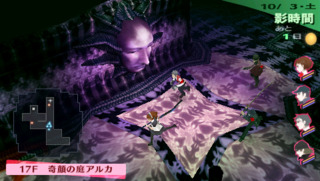
There are also a lot of smaller changes and additions that make P3P feel like a larger game than before. These include the ability to rescue people trapped inside Tartarus, as well as Skill Cards, which let you take direct control over what abilities your Personas can really have, regardless of normal restrictions. While the effects of those sorts of things aren't as immediately pronounced as the selectable gender and new combat, they still do a lot to make the game feel fresh and unique relative to other entries in the series.
Although these new features are very welcome additions and help make much of P3P feel like a fuller game than previous versions, they're not without their faults. The main issue to be had with a lot of them is that they have a bit of an identity crisis. There are places where it feels as though Atlus tried to incorporate new features in places that weren't originally flexible to incorporate them, an issue that's really noticeable with the Persona 4-originating additions. This means that some features come across as being functional, but not particularly fleshed out. The co-op actions in battle, for example, are lacking, giving everyone the exact same team-up attacks and mortal blow-taking mechanics, whereas Persona 4 had different possible actions that occurred depending on the character, such as Chie's tank-kicking Galactic Punt.
Even more dismaying is the fact that there's no sense of reward for receiving these features in P3P. Persona 4 made it so that you had to individually unlock those cooperative actions with each of the characters by Social Linking with them. It was a rewarding process, as it gave you a really tangible sense of bonding and teamwork with those characters. P3P, however, makes it an automatic process by having it so everyone unlocks them simultaneously as one the team Social Link levels up. It keeps all of the practicalities, but makes things devoid of any real symbolism or overall meaningfulness.
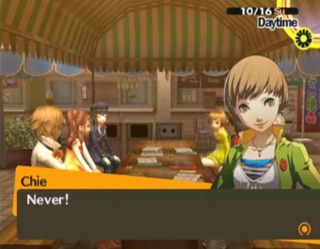
Social Links also have a similar issue where they're expanded, but still have the feeling of being too constrained within existing gameplay systems. It once again comes from the problem of the game trying to be like Persona 4 when it actually isn't. While P3P tries to make strides in having the Social Links be as flexible and integrated into the rest of the gameplay experience as possible, the fact that it still has Persona 3 underpinnings means it hits a brick wall in terms of how far it can actually go. The new Social Links are designed so you can actually speak your mind, but beyond that, the impact of their new features is limited. It all harkens back to Persona 4 without ever actually being able to replicate its success. The implications of that are that the personality traits have little bearing in the overall story and you won't be doing things to get on your friends' better sides during special events like you can in 4. It's all still comparatively a lot less dynamic and isolated in P3P. It's understandable that making the game operate like Persona 4 would require a hefty amount of structural revisions, but that doesn't make things any better when P3P tries to resemble its sequel in that regard anyway.
Then there's, of course, the matter of the game's presentation. In moving the game to the PSP, Atlus had to make a lot of concessions to fit the experience onto one UMD. Most of these are graphical and as such are very far-reaching. Non-Tartarus and battle-oriented environments are rendered entirely in isometric 2D, replacing your on-screen avatar with just a circular cursor as your means for navigating the overworld. Likewise, virtually all of the cutscenes, anime or otherwise, while still voice acted, now just consist of character portraits and backgrounds. This visual novel-esque shift wouldn't necessarily be problematic if the presentation of the game's plot was altered to better accommodate it, but the fact of the matter is that it usually isn't. What that mostly means is that characters act and speak as though you can still see what they're doing on the screen when you really can't. Usually what's happening is still pretty apparent so that the plot doesn't become any less accessible, but the subtraction of other on-screen cues like animation does mean that there's not as much immediate clarification at times about what's going on. You might hear running footsteps in a scene, for example, but without being able to see who's running at what, it's difficult to get a complete grasp of the situation until after the fact. Although these issues themselves don't break the game or harm the narrative quality all that much, it's still a jarring transition for a while, especially for those already familiar with the source material.
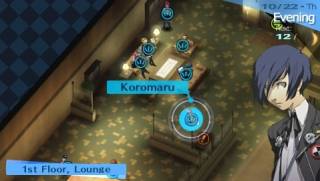
What is still there from a presentation standpoint is still mostly well-designed despite those constraints, though. High resolution two-dimensional assets such as the backgrounds and character portraits are well-detailed and have good, stylish direction driving them. The same can be said for the menu designs and other aspects of the interface, which continue to uphold the Persona series' tradition for sleekness and simplistic, yet pleasing color schemes. The polygonal graphics that are still present in the game during the Tartarus and battle portions also look really good on the PSP. Aside from a few minor graphical downgrades such as the lack of shadowing, the game more or less resembles the original version quite a bit, with the character and Persona designs still distinct and fun to see. The music, which includes some new tracks exclusively for P3P, is also great as well, showing that Shoji Meguro still has that special touch. The sound design likewise does well at accenting the atmosphere of the proceedings and the English dubbing is once again a joy to hear, too. Despite a few oddly inflected lines here and there, it still comes across as one of the best dubs in video games to this day, a legacy recent Persona games seem to be upholding consistently.
Even in the face of the game's problems, P3P is still a really great game. Not only does the story still hold up today, but Atlus' mission of updating the gameplay to Persona 4's standards is something worth celebrating. The additions of another gender, as well as a slew of other new features make P3P, for the most part, an even fuller package than Persona 3 and FES were. Even if the presentation is often far too spartan to do the story complete justice and a few new mechanics are underdeveloped, the game as a whole is still a fantastic package. While series veterans are most likely to get the most out of what's new and different in this version, newcomers to Persona 3's story will find a lot to like as long as they can deal with the mostly PSP-centric issues. P3P is therefore, in the end, a flawed, yet still excellent addition to a system in desperate need of more quality, lengthy RPGs that's worth owning and, for many players, replaying and reliving.
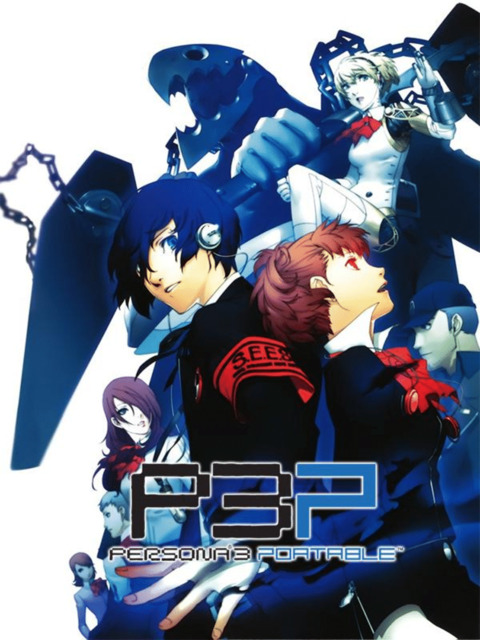
1 Comments